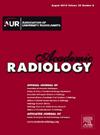使用临床和cmr衍生特征对保留射血分数的心力衰竭进行多模式风险分层:一种结合模型可解释性的方法。
IF 3.9
2区 医学
Q1 RADIOLOGY, NUCLEAR MEDICINE & MEDICAL IMAGING
引用次数: 0
摘要
理由和目的:保留射血分数的心力衰竭(HFpEF)由于其临床异质性,对诊断和预后提出了重大挑战。本研究提出了一个多模式、可解释的机器学习框架,该框架整合了临床变量和心脏磁共振(CMR)衍生特征,特别是心外膜脂肪组织(EAT)体积,以改善HFpEF患者的风险分层和结局预测。材料和方法:回顾性分析301例参与者(HFpEF组171例,对照组130例)。基线特征、cmr衍生的EAT体积和实验室生物标志物被整合到机器学习模型中。使用准确性、精密度、召回率和f1评分来评估模型的性能。此外,采用受试者工作特征曲线下面积(ROC-AUC)和精确召回曲线下面积(PR-AUC)来评估不同决策阈值下的判别能力。采用超参数优化和集成技术提高预测性能。结果:HFpEF患者表现出更高的EAT体积(70.9±27.3 mL vs. 41.9±18.3 mL)。结论:结合临床和cmr特征的可解释模型,特别是EAT体积,提高了对HFpEF诊断和预后预测的支持。这些发现强调了数据驱动的、可解释的方法对表征HFpEF表型的价值,并可能促进在选定人群中进行个性化风险评估。本文章由计算机程序翻译,如有差异,请以英文原文为准。
Multi-modal Risk Stratification in Heart Failure with Preserved Ejection Fraction Using Clinical and CMR-derived Features: An Approach Incorporating Model Explainability
Rationale and Objectives
Heart failure with preserved ejection fraction (HFpEF) poses significant diagnostic and prognostic challenges due to its clinical heterogeneity. This study proposes a multi-modal, explainable machine learning framework that integrates clinical variables and cardiac magnetic resonance (CMR)-derived features, particularly epicardial adipose tissue (EAT) volume, to improve risk stratification and outcome prediction in patients with HFpEF.
Materials and Methods
A retrospective cohort of 301 participants (171 in the HFpEF group and 130 in the control group) was analyzed. Baseline characteristics, CMR-derived EAT volume, and laboratory biomarkers were integrated into machine learning models. Model performance was evaluated using accuracy, precision, recall, and F1-score. Additionally, receiver operating characteristic area under the curve (ROC-AUC) and precision-recall area under the curve (PR-AUC) were employed to assess discriminative power across varying decision thresholds. Hyperparameter optimization and ensemble techniques were applied to enhance predictive performance.
Results
HFpEF patients exhibited significantly higher EAT volume (70.9±27.3 vs. 41.9±18.3 mL, p<0.001) and NT-proBNP levels (1574 [963,2722] vs. 33 [10,100] pg/mL, p<0.001), along with a greater prevalence of comorbidities. The voting classifier demonstrated the highest accuracy for HFpEF diagnosis (0.94), with a precision of 0.96, recall of 0.94, and an F1-score of 0.95. For prognostic tasks, AdaBoost, XGBoost and Random Forest yielded superior performance in predicting adverse clinical outcomes, including rehospitalization and all-cause mortality (accuracy: 0.95). Key predictive features identified included EAT volume, right atrioventricular groove (Right AVG), tricuspid regurgitation velocity (TRV), and metabolic syndrome.
Conclusion
Explainable models combining clinical and CMR-derived features, especially EAT volume, improve support for HFpEF diagnosis and outcome prediction. These findings highlight the value of a data-driven, interpretable approach to characterizing HFpEF phenotypes and may facilitate individualized risk assessment in selected populations.
求助全文
通过发布文献求助,成功后即可免费获取论文全文。
去求助
来源期刊

Academic Radiology
医学-核医学
CiteScore
7.60
自引率
10.40%
发文量
432
审稿时长
18 days
期刊介绍:
Academic Radiology publishes original reports of clinical and laboratory investigations in diagnostic imaging, the diagnostic use of radioactive isotopes, computed tomography, positron emission tomography, magnetic resonance imaging, ultrasound, digital subtraction angiography, image-guided interventions and related techniques. It also includes brief technical reports describing original observations, techniques, and instrumental developments; state-of-the-art reports on clinical issues, new technology and other topics of current medical importance; meta-analyses; scientific studies and opinions on radiologic education; and letters to the Editor.
 求助内容:
求助内容: 应助结果提醒方式:
应助结果提醒方式:


